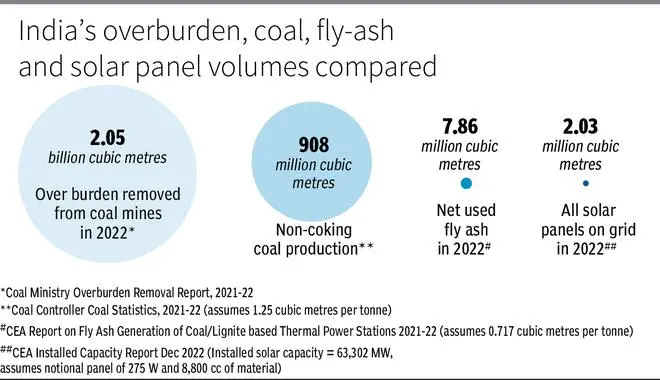As India’s energy transition progresses, some future implications of the movement towards a grid increasingly powered by solar, wind and storage have attracted analysis and commentary.
One such issue is the generation of new waste streams associated with renewable energy. The focus has been on discarded or superseded solar panels, although wind turbine blades have also received attention. The fate of tomorrow’s fleet of grid-scale batteries is also starting to enter the discussion, exemplified by last July’s joint NITI Aayog/UK Government report.
Planning now for future renewable energy waste is important. But it is equally important to have a realistic appreciation of the waste streams from conventional coal-based electricity generation and the potential of renewable energy to reduce them.
Here we show that the volume of material in all of the solar panels currently powering the grid in India amounts to about a quarter of the unused thermal power plant fly ash dumped every year and 1,000 times less than a year’s worth of overburden from coal mining. Media coverage and commentary often emphasise the scale of the waste challenge, sometimes in ominous terms. More positive reporting highlights the scale of the potential recycling market ($80 billion by 2050, according to a report of Rystad Energy’s forecast) or technical breakthroughs in extracting important minerals, such as silver and copper.
The recycling industry for renewable energy materials is in its infancy.
Renewable recycling
The Institute for Energy Economics and Financial Analysis (IEEFA) has outlined regulatory, financial and policy steps India can take to establish a viable renewable energy recycling industry. IEEFA welcomes the announcement late last year of the new E-Waste (Management) Rules, which place obligations on solar manufacturers and producers to officially register projected waste and stockpiles and identify recyclers.
To put the solar waste component into perspective, we depict in the figure below the volume of all the solar panels currently providing power to India’s grid – 63,302 megawatts (MW) at the end of 2022, or roughly 215 million panels. The figure provides the annual volumes of non-coking coal mined in India, mostly used for power, overburden (rock and soil removed to access coal), and waste fly ash from thermal power plants dumped in ash ponds or on dry ground.
In reality, only a small fraction of the panels represented in the figure are currently entering the waste stream. But renewable energy’s penetration of India’s power grid will ultimately see panels failing or reaching obsolescence in appreciable numbers. Therefore, a comparison using the possible renewable energy waste stream decades hence is appropriate and conservative.
Qualified comparison
There are important qualifiers for each comparison with coal, overburden and fly ash. Firstly, thermal coal is not waste, though an unknown quantity is lost in handling and transport, as well as airborne dust.
Secondly, it is true that a substantial quantity of overburden remains on mine sites, and much of it ultimately re-fills the voids left by mining. Silica-rich overburden can replace other sources, such as sand mined from rivers, although such use represents only a tiny proportion of the total. Nevertheless, this still leaves vast quantities dumped on the periphery of mines, sometimes polluting waterways with high metal content in leachates or affecting farm productivity.
Finally, the volume of fly ash shown in the figure is only about a tenth of the annual quantity generated because much is reused in construction materials. India’s latest fly-ash report shows a net reuse rate of 91 per cent. Not only is this a considerable increase from previous years, but it also represents a double win environmentally – less waste and pollution on the one hand and greater displacement of other raw materials on the other. But this accomplishment should not obscure the significant pollution associated with the unused quantities, especially the periodic ruptures or overflows of ash ponds that harm livelihoods and health.
Nor should the 91 per cent net reuse figure hide the fact that 41.1 million tonnes — nearly four times greater than the net unused quantity depicted in the figure — was still dumped in Uttar Pradesh, Madhya Pradesh, Jharkhand, Chhattisgarh and West Bengal last year. Only a small proportion of this accumulation is likely to find its way to States where it is in demand.

This is because, in addition to the cost, it would rely on the same bulk rail transport that can barely move coal from the east to power plants elsewhere.
The risks of poorly managed waste for renewable energy are real and demand proper planning and regulation. But be wary of suggestions that it is a disaster in the making. Coal-fired power remains an overwhelmingly larger creator of far less well-controlled and generally more damaging waste, which renewable energy has the potential to limit, reduce and ultimately eliminate.
The writer is a researcher tracking India’s energy transition





Comments
Comments have to be in English, and in full sentences. They cannot be abusive or personal. Please abide by our community guidelines for posting your comments.
We have migrated to a new commenting platform. If you are already a registered user of TheHindu Businessline and logged in, you may continue to engage with our articles. If you do not have an account please register and login to post comments. Users can access their older comments by logging into their accounts on Vuukle.